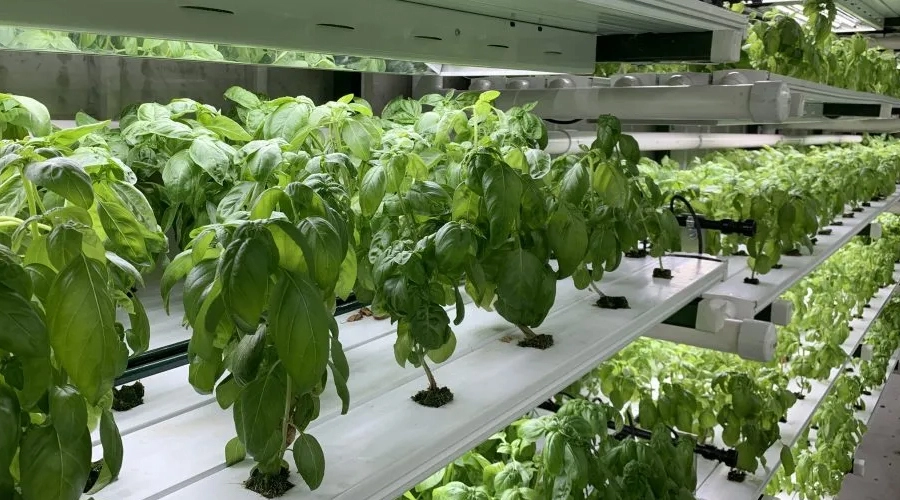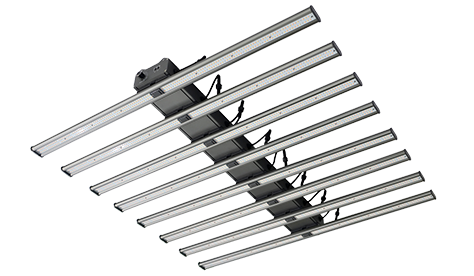Auf die Hydroponik Die Reise kann aufregend und überwältigend sein, insbesondere wenn sie mit den unzähligen Auswahlmöglichkeiten von hydroponischen Systemen konfrontiert ist.
Lassen Sie uns in dieser Erforschung von hydroponischen Systemen die Geheimnisse von sieben unterschiedlichen Techniken enträtseln: Deep Water Culture (DWC), Nutrient Filmtechnik (NFT), Aeroponik, Tropfsystem, Wicksystem, vertikale Hydrokroponik und Ebbe & Flusssystem.
Jede Methode ist ein einzigartiger Weg, um Pflanzen in einer bodenlosen Umgebung zu kultivieren und ihre Feinheiten zu verstehen, kann die Verwirrung der Entscheidungen in ein aufregendes Abenteuer verwandeln.
Was Sie wählen, spielt keine Rolle, solange Sie hier etwas lernen und den Prozess genießen. Wenn Sie sich mit verschiedenen Möglichkeiten zur Wachstum des Hydroponikzustands vertraut machen, erleichtert die Navigation in der hydroponischen Systemliste für Sie.
Tiefwasserkultur (DWC)
Lush -Wurzelsysteme, die in Nährlösung aufgehängt sind - das ist DWC!
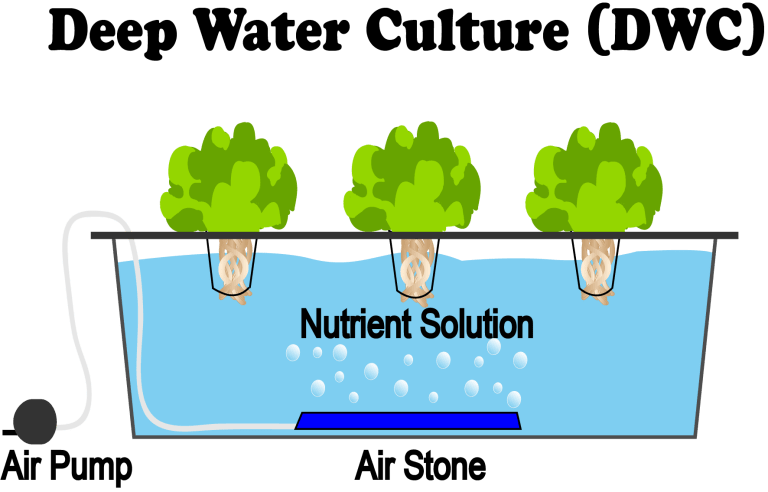
Arbeitsprinzip von DWC:
Untergetauchte Wurzeln: Pflanzenwurzeln sind vollständig in eine nährstoffreiche Wasserlösung eingetaucht.
Schwimmende Plattform oder Netto -Topf: Wurzeln werden häufig im Wasser mit einer schwimmenden Plattform oder einem Nettentopf aufgehängt, sodass sie auf die Nährstofflösung zugreifen können.
Kontinuierlicher Sauerstoffverhältnis: Sauerstoff wird den Wurzeln durch Luftsteine oder Diffusoren zur Verfügung gestellt, die Blasen im Wasser erzeugen.
Nährstoffabsorption: Pflanzen absorbieren wesentliche Nährstoffe direkt aus dem Wasser und fördern die effiziente Nährstoffaufnahme.
Hydroponische Umgebung: DWC fungiert als Hydroponiksystem, wodurch der Boden erforderlich ist und sich auf Wasser zur Nährstoffabgabe angewiesen hat.
Das DWC -System ist ein einfaches und praktisches hydroponisches System, das für Haus-, Bauernhof- und kommerzielle Anbau geeignet ist.
Ernten für DWC:
Gemüse: Salat, Spinat, Grünkohl, Gurke, Paprika, Tomaten,
Kräuter: Basilikum, Minze, Petersilie, Koriander usw., usw.
Früchte: Erdbeeren, Tomaten,
Blumen: Ringelblumen, Zwergmorgenmorgen usw.,
Cannabis (wo legal).
Vorteile:
- Wasser- und nährstoffartige, reduzierende Wasserressourcenverbrauch.
- Hohe Raumeffizienz, geeignet für einen großen, mittleren und kleinen Anbau.
- Einfaches Setup, leicht zu warten.
- Hoher Ertrag, schnelles Wachstum.
Nachteile:
- Anfällig für Wasserverschmutzung, die regelmäßige Lösungsänderungen erfordern.
- Wurzeln können leicht verrotten und die Aufmerksamkeit auf die Konzentration der Wassertemperatur und der Nährstofflösung erfordern.
- Schlechte Mobilität, Flexibilität bei Bewegung oder Umbau -Setups.
- Anfälliger für Systemfehler wie Stromausfälle oder Fehlfunktionen von Geräten.
Nährfilmtechnik (NFT)
Pflanzenwurzeln wachsen in einer dünnen Schicht fließender Nährstofflösung - das ist NFT!

Arbeitsprinzipien von NFT:
Kontinuierlicher Fluss: Ein dünner Film aus nährstoffreichem Wasser wird kontinuierlich entlang eines geneigten Kanals oder einer abgerissenen Rinne zirkuliert.
Wurzelexposition: Pflanzenwurzeln werden im Film aufgehängt und einem konstanten Fluss von Nährstoffen und Sauerstoff ausgesetzt.
Schwerkraftgetrieben: Die Steigung des Kanals ermöglicht die Nährstofflösung durch die Schwerkraft über die Wurzeln.
Das NFT-System ist ein effizientes und wassersparendes hydroponisches System, das für Haus-, Bauernhof- und Handelsanbau geeignet ist. Unser vertikales System SG40 nutzt das NFT -System zum Pflanzen.
Ernte für NFT:
Gemüse: Salat, Spinat, Rucola, kleine Sorten von Paprika;
Kräuter: Kräuter, Basilikum, Koriander, Minze, Petersilie, Schnittlauch;
Andere Kulturen: Mikrogreens, bestimmte Gurkensorten, bestimmte Blütenpflanzen (zu dekorativen Zwecken);
Beeren: Erdbeeren.
Vorteile:
- Nachhaltige zirkulierende Nährstofflösung, Wasser und nährstoffartige Verringerung des Verbrauchs von Wasserressourcen.
- Das Design des Systems ist in der Regel kompakt und maximiert die Raumauslastung.
- Hoher Ertrag, schnelles Wachstum.
Nachteile:
- Hohe Abhängigkeit von Strom, die sich auf eine kontinuierliche Stromversorgung der Pumpe verlassen, um den Nährstofflösungfluss aufrechtzuerhalten.
- Nicht geeignet für große oder schwere fruchthaltige Pflanzen.
- Komplexes System, das regelmäßig Überwachung und Wartung erfordert.
Aeroponik
In einem aeroponischen System werden Pflanzenwurzeln direkt der Luft ausgesetzt, und die Nährstofflösung wird in einen Nebel auf die Oberfläche der Wurzeln gesprüht.

Arbeitsprinzip der Aeroponik:
Misting -Wurzeln: Die Aeroponik spielt Pflanzenwurzeln in der Luft und liefert Nährstoffe über einen feinen Nebel oder Aerosol.
Hochsauerstoffhaltig: Wurzeln sind einem hohen Sauerstoffgehalt ausgesetzt und fördern die schnelle Nährstoffabsorption und das Wachstum.
Nährstoffreicher Nebel: Die Nährstofflösung wird in Nebelform direkt auf die Wurzeln gesprüht, wodurch die Nährstoffaufnahme maximiert wird.
Minimaler Wasserverbrauch: Effiziente Verwendung von Wasser, da es direkt kontrolliert auf die Wurzeln aufgetragen wird.
Das aeroponische System ist ein effizientes und wassersparendes Hydroponiksystem, das für seine hohe Ausbeute bekannt ist. Unsere Hydroponikürme Verwenden Sie das Aeroponic -System, das von den Landwirten für die Anbindung einer Vielzahl von Pflanzen wie Blattgemüse, Kräutern und Früchten sehr beliebt ist.
Kulturen für Aeroponik:
Blattgemüse: Salat, Spinat, Grünkohl.
Kräuter: Basilikum, Koriander, Minze.
Erdbeeren: Oft aeroponisch für eine optimale Fruchtentwicklung angebaut.
Microgreens: Gut geeignet für aeroponische Systeme.
Vorteile:
- Hohe Wachstumsraten: Schnelles Pflanzenwachstum aufgrund erhöhter Sauerstoff- und Nährstoffabsorption.
- Wassereffizienz: minimaler Wasserverbrauch im Vergleich zum traditionellen Bodenanbau.
- Präzise Nährstoffkontrolle: Ermöglicht eine präzise Kontrolle über die Nährstoffkonzentration und optimiert die Gesundheit der Pflanzen.
- Raumeffizienz: Gut für vertikale Landwirtschaft und begrenzte Weltraumumgebungen geeignet.
Nachteile:
- Systemkomplexität: Erfordert mehr technisches Wissen für das Einrichten und Wartung.
- Risiko für die Fehlfunktion der System: Potenzial für Verstopfung von Düsen oder Pumpenfehlern.
- Leistungsabhängigkeit: Die kontinuierliche Stromversorgung ist entscheidend für die Aufrechterhaltung von Nebelzyklen.
- Anfangskosten: höhere anfängliche Einrichtungskosten im Vergleich zu anderen Hydroponikmethoden.
Vertikale Hydrokultur
In einem vertikalen hydroponischen System wachsen Pflanzenwurzeln in vertikal gestapelten Schichten.

Konzept- und Arbeitsprinzip:
Vertikale Anbauflächen: Verwendet vertikale Strukturen, um Pflanzen in gestapelten Schichten oder Türmen zu züchten.
Nährstoffabgabe: Nährstoffreiches Wasser wird auf der vertikalen Oberfläche zirkuliert oder abtropft, wodurch Pflanzen mit wesentlichen Elementen versorgt werden.
Schwerkraftunterstützung: Wasser fließt von der Oberseite der Struktur hinunter und nutzt die Schwerkraft, um niedrigere Werte zu erreichen.
Stapelte wachsende Betten: Pflanzen sind in gestapelten Betten oder Türmen angeordnet und optimieren den Raum in einer vertikalen Ebene.
Vertikale Hydroponiksysteme eignen sich für Heim-, Farm- und Handelsanbau.
Unser vertikales Gartensystem SG40 wird von Benutzern auf verschiedenen Bereichen hochgelobt. Es ist besonders gut geeignet für Bildungsforschung, hydroponische Ausbildung, Simulation von Pflanzenfabriken, kommerzielle Ausstellungen und Gärtnerei zu Hause.
Kulturen für vertikale Hydroponik:
Blattgemüse: Salat, Spinat, Grünkohl, Schweizer Mangold, Rucola;
Kräuter: Kräuter, Basilikum, Koriander, Minze, Petersilie;
Tomaten und Paprika: Bestimmte Sorten gedeihen unter vertikalen Wachstumsbedingungen, insbesondere bei kompakten Wachstumsgewohnheiten;
Andere Kulturen: Mikrogreen, Radieschen, Hülsenfrüchte und einige blühende Pflanzen für dekorative Zwecke;
Vorteile:
- Maximiert die Nutzung von begrenztem Raum, geeignet für städtische oder begrenzte Räume für den Anbau;
- Hohe Ausbeute in einem kleinen Gebiet, erhöhte Pflanzendichte und -ausgang;
- Hohe Automatisierung, Reduzierung der Arbeitskosten;
- Die vertikale Anordnung erhöht die Exposition gegenüber künstlichen oder natürlichen Lichtquellen;
Nachteile:
- Komplexes System erfordert spezielles Wissen für Design und Wartung.
- Die anfänglichen Kosten während der Implementierung können insbesondere für Automatisierungssysteme hoch sein.
- Die Gewährleistung einer gleichmäßigen Nährstoffverteilung für jede Schicht kann eine Herausforderung sein.
Tropfsystem
Die Pflanzenwurzeln erhalten Nährstofflösung über ein Tropfbewässerungssystem - das ist das Tropfsystem!
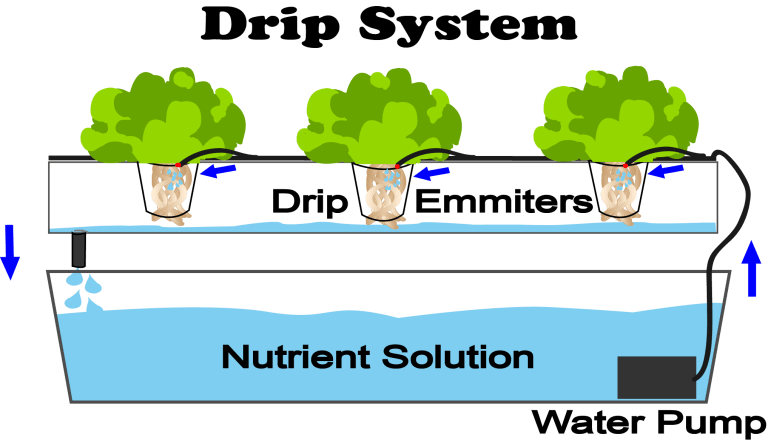
Arbeitsprinzip:
Einzelner Pflanzen Tropf: Die Nährstofflösung wird direkt durch einzelne Tropfemitter an jede Pflanze geliefert.
Regelmäßige Intervalle: Das System arbeitet mit einem Timer und bietet kontrollierte und regelmäßige Tropfen der Nährstofflösung.
Rezirkulation: Überschüssige Nährstofflösung, die nicht von Pflanzen absorbiert wird, wird durch das System gesammelt und recirculiert.
Tropfsysteme eignen sich für Heim-, Farm- und Handelsanbau.
Pflanzen für Tropfsysteme:
Gemüse: Tomaten, Paprika, Gurken, Zucchinis, Salat, Spinat, Brokkoli;
Früchte: Erdbeeren, Blaubeeren, Melonen (wie Wassermelone und Cantaloupe);
Kräuter: Basilikum, Thymian, Oregano, Rosmarin, Minze, Koriander;
Andere Ernte: Blumen (wie Rosen, afrikanische Gänseblümchen, Zwergmorgen), Erbsen.
Vorteile:
- Wassersparend, reduziert den Gesamtwasserverbrauch.
- Erhöhter Ertrag, was den Anbau von mehr Pflanzen ermöglicht.
- Hohe Automatisierung, was zu reduzierten Arbeitskosten führt.
- Einfach zu erweitern und Flexibilität bei der Skalierung des Systems zu bieten.
- Geeignet für eine Vielzahl von Pflanzen, vielseitig in der Anwendung.
Nachteile:
- Tropfbewässerungsköpfe können aufgrund der Ansammlung von Sediment oder einer Nährstoffausfällung anfällig für Verstopfung sein.
- Jeder Stromausfall kann zu Systemunterbrechungen führen.
- Das Einrichten eines Tropfbewässerungssystems erfordert möglicherweise technisches Wissen.
- Es ist Vorsicht erforderlich, um Überwässerung zu vermeiden, insbesondere in Situationen mit hohen Durchflussraten oder verlängerten Dauer.
Dochtsystem
Die Pflanzenwurzeln wachsen in wasserabsorbierenden Baumwolle, und die Nährstofflösung wird durch die wasserabsorbierende Baumwolle an die Wurzeln übertragen-das ist das Docht-System!
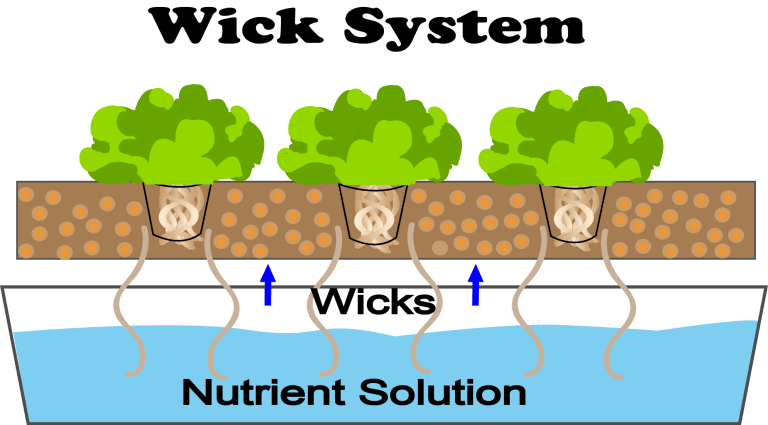
Arbeitsprinzip:
Kapillarwirkung: Stützt sich auf Kapillarwirkung durch Dochts (normalerweise aus Filz oder anderen saugfähigen Materialien), um die Nährstofflösung für Pflanzenwurzeln zu liefern.
Passive Bewegung: Die Nährstofflösung bewegt sich von einem Reservoir über Dochte zu dem wachsenden Medium, in dem Pflanzenwurzeln sie absorbieren.
Kontinuierliche Feuchtigkeit: Hält im wachsenden Medium ein konsistentes Feuchtigkeitsniveau.
Für diese Methode sind keine Wasserpumpen oder andere Geräte erforderlich, was sie für die Gärtung zu Hause geeignet ist.
Kulturen für Dochtsysteme:
Kräuter: Basilikum, Minze, Koriander, Petersilie, Schnittlauch;
Blattgemüse: Salat, Spinat, Grünkohl, Schweizer Mangold;
Erdbeeren: Geeignet für kleinere Erdbeerensorten;
Andere Kulturen: Kleine Blütenpflanzen, wartungsarme Haushaltspotenpflanzen.
Vorteile:
- Einfach zu installieren und zu bedienen, ideal für Anfänger von Hydroponik.
- Erfordert minimale Ausrüstung, kostengünstige Kosten, geeignet für die Gartenarbeit zu Hause.
- Der Strom arbeitet nicht passiv ohne Wasserpumpen oder elektrische Komponenten.
- Kompaktes Design, ideal für kleine oder Innengarten.
Nachteile:
- Niedrige Ausbeute, geeignet für die Kultivierung kleiner Kulturen, nicht für große oder schwer fruchthaltige Pflanzen geeignet.
- Langsame Nährstoffabsorption und Kapillarwirkung können zu einer langsameren Nährstoffaufnahme führen.
- Es kann eine ungleichmäßige Verteilung von Nährstoffen im gesamten wachsenden Medium auftreten.
- Risiko einer Überwässerung, die sich in bestimmten Situationen auf die Wurzelgesundheit auswirken kann.
Ebbe und Flusssystem
In diesem System wachsen Pflanzenwurzeln in einem wachsenden Medium, und die Nährstofflösung wird durch eine Wasserpumpe in das Kultivierungsbett verteilt, bevor sie erneut abgelassen werden.

Arbeitsprinzip:
Periodische Überschwemmungen und Entwässerung: Die Nährstofflösung überflutet das wachsende Medium regelmäßig und reicht dann in ein Reservoir zurück.
Tauchpumpe: Eine Tauchpumpe wird verwendet, um das wachsende Bett zu überfluten, und eine Abflusspumpe entfernt überschüssige Lösung.
Zeitgesteuerte Zyklen: Funktioniert zeitgesteuerte Zyklen, wobei Hochwasser- und Abflussintervalle von einem Timer gesteuert werden.
Das Ebbe und das Flusssystem sind für Heim-, Bauernhof- und Handelsanbau geeignet.
Ernten für Ebb & Flusssystem:
Gemüse: Tomaten, Paprika, Gurken, Salat, Spinat.
Kräuter: Basilikum, Koriander, Minze, Petersilie.
Blumen: Rosen, Gerbera -Gänseblümchen, Petunias.
Früchte: Erdbeeren, Melonen.
Vorteile:
- Regelmäßige Bewässerung sorgt für eine optimale Nährstoffabgabe und -absorption durch Pflanzen.
- Geeignet für verschiedene Arten von Pflanzen, die den Bedürfnissen verschiedener Pflanzen entsprechen.
- Hochwasser- und Abflusszyklen verringern im Vergleich zu kontinuierlichen Fließsystemen das Risiko von Überwässerung.
Nachteile:
- Abhängigkeit von Strom, die Strom für den Betrieb von Tauchpumpen und Entwässerungspumpen erfordert.
- Komplexer als passive Systeme, die sorgfältige Installation und Wartung erfordern.
- Pumpenfehler können Überschwemmungs- und Entwässerungszyklen stören.
- Erfordert einen größeren Raum, der in bestimmten Situationen möglicherweise nicht so platzeffizient ist wie kleinere Systeme.
Jayes
Als Digital Marketing Manager bei AUXGROW vereint Jayes eine Leidenschaft für Hydrokultursysteme mit Fachwissen für LED-Wachstumslampen. Mit praktischer Erfahrung und einem tiefen Verständnis führt Jayes Sie durch die Welt des nachhaltigen Anbaus.

